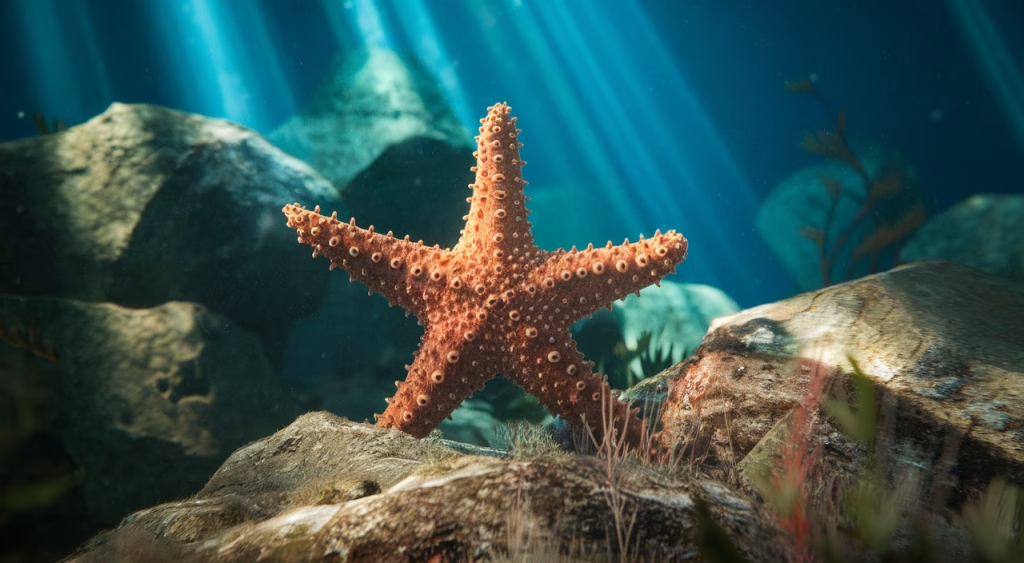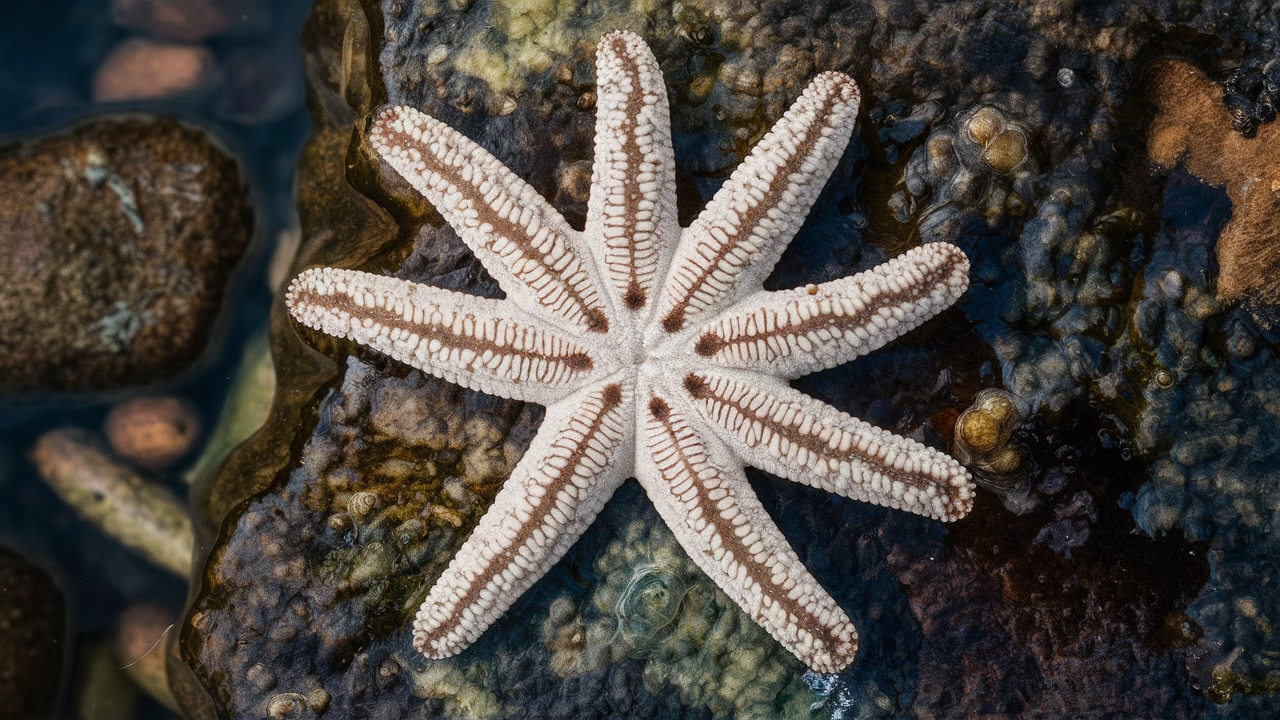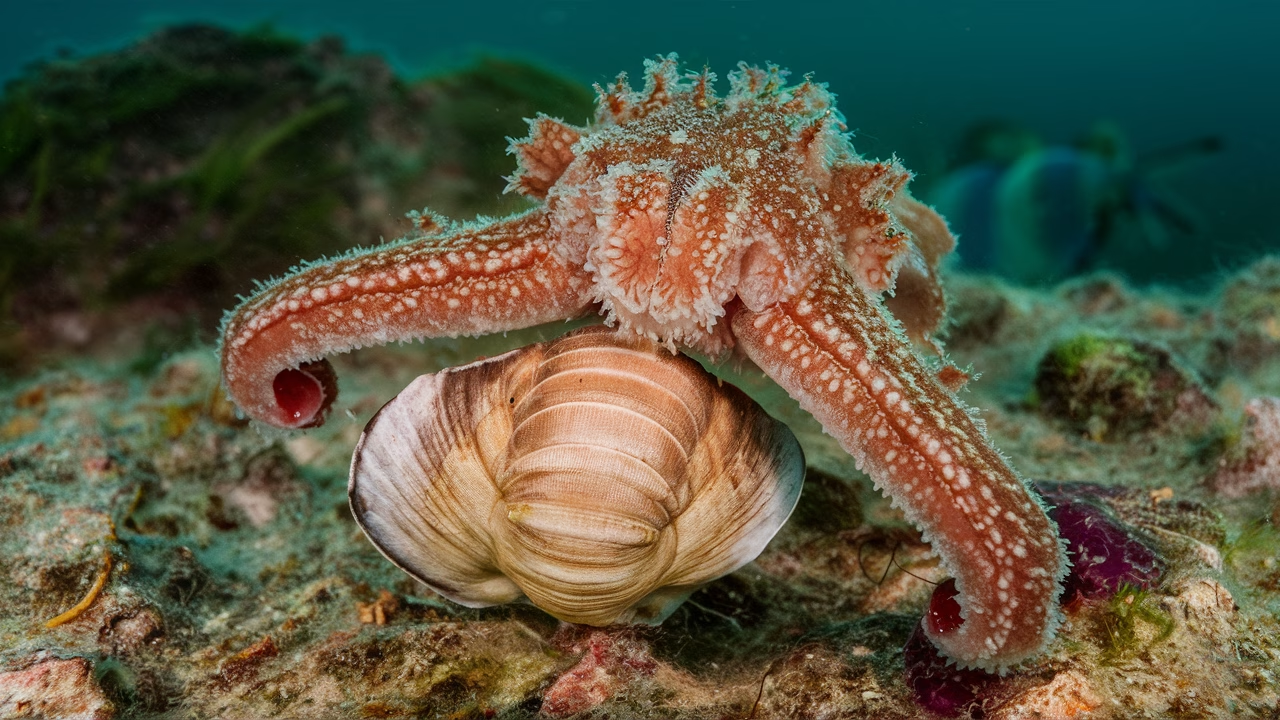How do sea stars use the eyes at the tips of their arms?
Sea stars have eyes at the tips of their arms that detect light and shadows in their surroundings. While these sea star eyes don’t offer high-resolution images like human eyes, they help sea stars navigate their environment, find shelter, and locate food. These starfish eyes are crucial for survival, offering them essential visual capabilities in their slow-paced, bottom-dwelling lifestyle on the ocean floor.
TL;DR: Sea Stars Have Eyes at the Tips of Their Arms — Here’s Why That Matters
- Built-in eyes: Sea stars have rudimentary eye spots at the tip of each arm, allowing them to detect light and general shapes.
- Survival aid: This primitive starfish vision helps sea stars avoid predators and obstacles while seeking out coral reefs and food sources.
- Evolutionary marvel: These sea star eyes evolved to suit their unique radial body plan and ocean-floor lifestyle.
- Navigation system: Each arm works somewhat independently, giving sea stars a decentralized sensory map of their surroundings.
- Underrated sophistication: Though often overlooked, this vision plays a vital role in starfish behavior and ecological strategy.
The Evolution of Sea Stars’ Eyes
Development of Eyes on Sea Stars’ Arms
To understand why sea stars have eyes at the tips of their arms, we need to explore their evolutionary journey. Most sea creatures evolved centralized nervous systems with paired, forward-facing eyes. Sea stars took a different path. Belonging to the phylum Echinodermata, sea stars developed a decentralized setup. Their radial symmetry places equal importance on each arm — making it evolutionarily advantageous to have photoreceptors (simple eyes) at every arm tip.
These starfish eyes are called ocelli — small black or reddish dots that detect light intensity and nearby shapes. Unlike human eyes, sea star eyes cannot focus, but for their ocean floor lifestyle, this simple vision system works perfectly. These eyes primarily distinguish between light and dark areas, a crucial ability for survival where subtle lighting changes can signal safety or danger.
Survival Advantages of this Unique Vision
Why did sea stars evolve eyes at the tips of their arms? Because this adaptation provides real survival benefits. Sea stars move slowly, making them vulnerable to predators. Their arm-tip eyes help detect looming shadows from passing predators and notice shifting currents that indicate prey or shelter nearby. It’s like having a built-in early warning system.
What’s remarkable is how these sea star eyes coordinate. Researchers have observed sea stars with all five arm-tip eyes successfully navigate around obstacles to reach food sources — but this ability disappears when the eyes are removed. This proves that starfish vision helps each limb maintain behavioral independence while working toward shared survival goals.
Behavioral Insights from Sea Stars’ Vision
Imagine navigating a dim underwater landscape with only basic light detection — that’s how sea stars move across the seafloor using their arm-tip eyes. Each arm functions like a sensory probe, scanning the terrain, detecting brightness variations, and guiding the creature toward food, mates, or safety.
Laboratory experiments reveal the importance of sea star eyes. When researchers placed sea stars several meters from coral reefs, the animals successfully oriented and moved toward the reef — but only with intact eyes. Remove those starfish eyes, and you get random, purposeless movement. This confirms that these simple eyes aren’t just backup sensors — they’re essential organs for navigation and decision-making.
Impact of Visual Ability on Feeding Behavior
Starfish vision plays a crucial role in feeding behavior. Sea stars prey on mollusks like clams and oysters, requiring reliable approach strategies made possible by their arm-tip eyes.
When potential prey is detected through sight, smell, or touch, the sea star begins its methodical approach. The arm that first sensed the prey guides the movement, while other arms contribute by scanning for shadows that confirm the prey’s location. Multiple sea star eyes work together, creating subtle but effective hunting coordination on the seafloor.
Comparing Marine Vision: Sea Stars vs. Other Creatures
| Marine Animal | Primary Eyesight Type | Field of Vision | Vision Purpose |
|---|---|---|---|
| Sea Star | Ocelli (Arm-tip eyes) | Radial (360°) | Light detection and navigation |
| Shrimp | Compound eyes | Wide-angle, multi-directional | Motion detection |
| Shark | Camera-like eyes | Forward & side | High-resolution target tracking |
| Octopus | Camera eyes with lens | Forward | Color and shape vision |
Why This Evolutionary Strategy Works So Well
Evolution favors what works, and sea star eyes represent an elegant solution. While starfish vision may seem primitive, complex visual systems would waste energy for slow-moving, bottom-dwelling creatures. Instead, sea stars evolved decentralized nerve rings and sensory responses that distribute control among their limbs.
This modular design of sea stars having eyes at the tips of their arms provides several advantages:
- Damage control: If one arm is lost, the remaining starfish eyes continue functioning.
- Efficient scanning: Vision is distributed across space, making environmental monitoring more effective.
- Low-energy use: Simple optical systems require minimal processing power.
This vision strategy mirrors modern distributed sensor networks — each component handles a specific task while contributing to overall awareness.
Final Thoughts: A Sea Star’s View of the World
What does the ocean look like through sea star eyes? Probably like a diffused landscape of brightness, shadow, and proximity cues. Starfish vision isn’t about sharpness or color — it’s about survival, orientation, and thriving in the slow-motion world of the seafloor.
Next time you encounter a sea star in a tidepool or aquarium, notice those tiny dots at each arm tip. These sea star eyes are windows into a unique sensory world — one shaped by millions of years of evolution and the remarkable adaptation of having eyes at the tips of their arms.
Frequently Asked Questions
- Do sea stars have eyes on their arms?
Yes, sea stars have primitive eyes called ocelli located at the tip of each arm. These eyes help detect light and shadows. - How do sea star eyes differ from human eyes?
Unlike humans, sea star eyes can’t form detailed images. They’re best at sensing light intensity and navigating local terrain. - Why do sea stars need eyes?
Sea stars use their eyes to avoid dangers, find food, and orient toward or away from structural features like coral reefs. - Can sea stars see in color?
No, sea stars lack color vision. Their sight is limited to detecting contrasts and brightness. - What happens if a sea star loses an arm?
If a sea star loses an arm, it may lose an ocellus, but it can often regenerate the limb and its sensory capabilities. - Are all sea stars equally reliant on vision?
Not necessarily. Some deep-sea species put more reliance on touch or chemical cues due to light scarcity. - How are sea stars studied in the lab?
Researchers use light manipulation and obstacle courses to observe behavioral changes when sea stars use or lose sight function.





